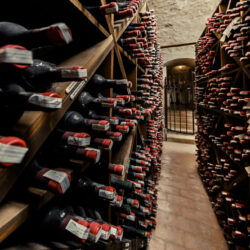Sparkling tea has created its own niche in hospitality. Understanding where it is from and the way it is made is the key to understanding why it is so suited to restaurant drinks lists.
The growth of no- and low-beverage offer in restaurants is being driven by consumer demand as diners look for alternatives to match more complex drinks with delicious food.
It is no longer just about offering sparkling water to people who don’t want to drink alcohol. Non-alcohol drinks’ volumes grew 47% in 2022-23, just in the UK, and the trend is expected to continue in the coming years. In fact, statisticians forecast no-alcohol volume growth of 19% between 2023 and 2028.*

As a result, sommeliers are looking to expand their drinks expertise and find out more about premium non-alcoholic alternatives. A recent masterclass gave Sommelier Edit members a deep-dive into the elegance and versatility of tea and Saicho Sparkling Teas, hosted by tea expert Leona De Pasquale DipWSET, wine and tea educator and founder of Camellia and Vine.
Origin is key when it comes to tea, according to Leona de Pasquale. “All tea comes from one plant, Camelia sinensis, but depending on the type, terroir and production method there are huge variety of flavours, from floral to fruity, nutty to smoky, candied to umami, ” she explains. “The intricate interplay between tea leaves, altitude, soil composition, and weather conditions endow each tea with a signature flavour profile that echoes the concept of terroir found in winemaking.” Very similar to wine, tea growers work to maintain and balance the sensitive ecological bio-diversity of their regions to ensure preservation and consistent harvests.
The tea aroma and tasting allows you to deepen your sensory skills as you can taste and smell the complex flavours and aromas of single-origin tea for yourself. This helps to deepen your understanding of the immense possibilities for good sparkling teas in a restaurant setting.
“Flavour is important too, as you can imagine,” she says, “offering an array of flavours, as diverse as with wine. There are thousands of tea varieties. From the grassy, vegetal notes of green teas to the floral, honeyed nuances of oolong, to bolder spicy black teas. Each type of tea reveals unique characteristics shaped by its terroir and processing.” Indeed, terrior, climate and production methods all play a key role in tea cultivation, just like wine.”
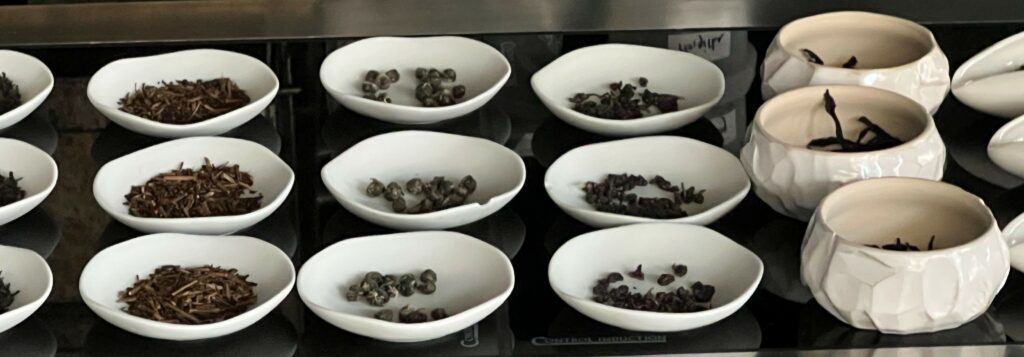
To illustrate this Leona took the assembled sommeliers through a tasting of hot teas before launching into the sparkling variety, explaining the crucial role that oxidation plays in the role of tea making and subsequent conversion to delicious sparkling teas. For example, white teas have very low oxidation due to the enzymes in the tea and therefore need little processing. Black teas, at the other end of the scale are highly oxidised, giving them their unique taste and flavour. On the taste spectrum, in between those two extremes come Green teas with no oxidation and Oolong teas which are semi-oxidised.
The aim of this part of the masterclass according to Ravinder Atwal, global marketing director at Saicho Sparkling Teas is to highlight Saicho’s journey, “and how its carefully selected single-origin teas are crafted into exquisite sparkling drinks that pair perfectly with food.” She adds, “The tea aroma and tasting allows you to deepen your sensory skills as you can taste and smell the complex flavours and aromas of single-origin tea for yourself. This helps to deepen your understanding of the immense possibilities for good sparkling teas in a restaurant setting.”
Another important aspect of tea tasting is the tannin. Leona says, “Much like fine wine, tannins can also be found in tea leaves which support a surprising yet delightful astringency, contributing to their texture and mouth-feel.” She elaborates that, “tannins give tea a dry, bitter flavour and a distinct puckering sensation in the mouth and also determine the colour of tea, from the rich hues of black tea to the soft tones of green tea.” All of which is essential in the production of sparkling tea.
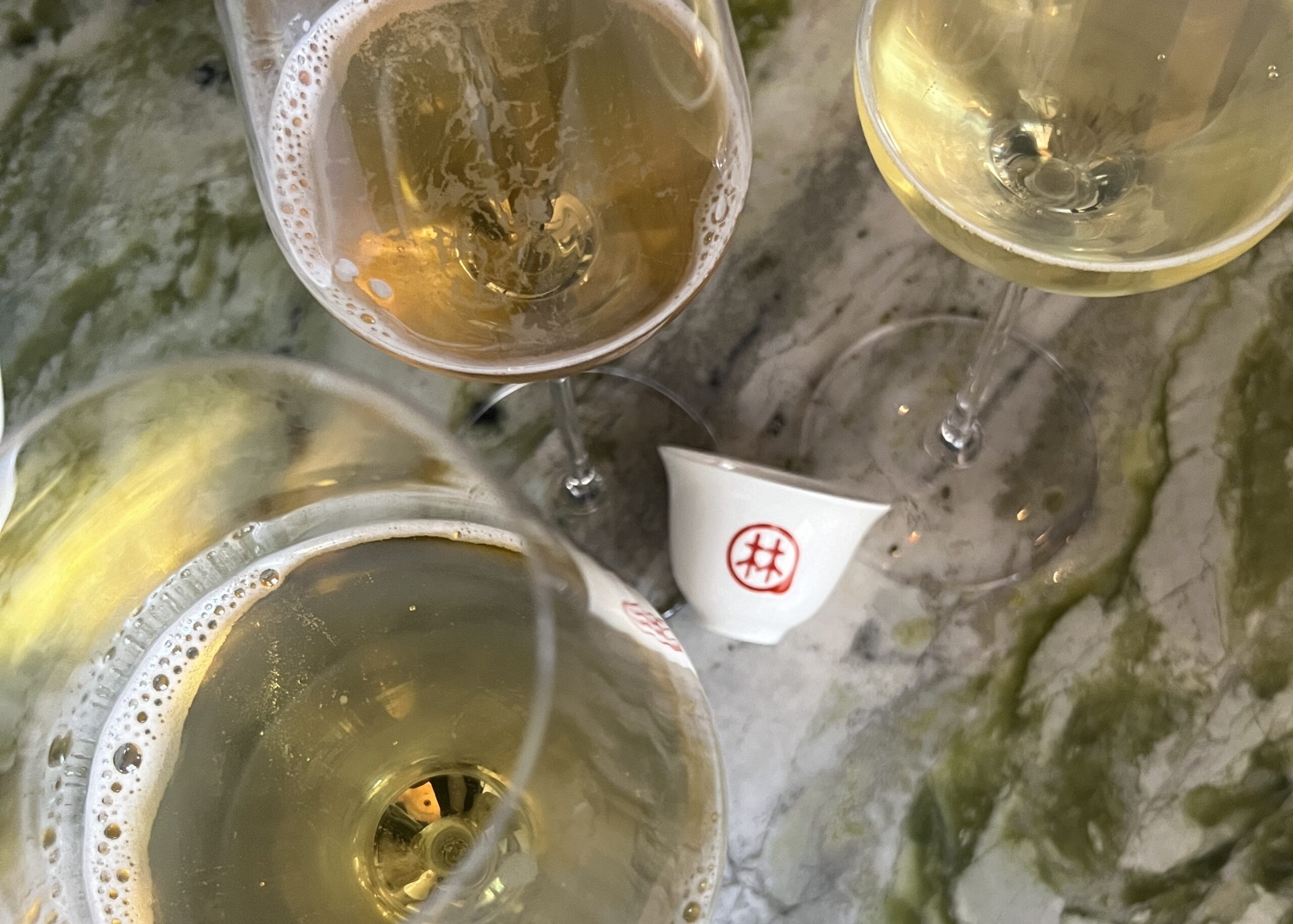
A lot of care and attention goes into making Saicho Sparkling Teas, reveals Ravinder, “Like wine, production of great sparkling tea is reliant on meticulous harvesting, oxidation, and sometimes fermentation to shape unique flavours. Skilled artisans, from tea masters to vintners, apply expertise honed over generations, transforming leaves and grapes into complex, nuanced beverages.” Saicho makes three sparking teas; Jasmine, Darjeeling and Hojicha.
The intricate interplay between tea leaves, altitude, soil composition, and weather conditions endow each tea with a signature flavour profile that echoes the concept of terroir found in winemaking.
Interestingly, each tea is cold brewed for 24 hours, to extract the most delicate and complex flavours giving very different flavour profiles when compared to hot brewing. It’s far more delicate, with enhanced aromatics and better-balanced astringency, creating flavour profile and mouthfeel which pairs perfectly with food. Each cold brewed tea is then finely balanced with a dash of acidity and a hint of sweetness. Saicho uses Airen (a native Spanish varietal) grape juice which adds a beautifully rounded texture. The drinks are then delicately sparkled to enhance the natural aromatics of the tea.
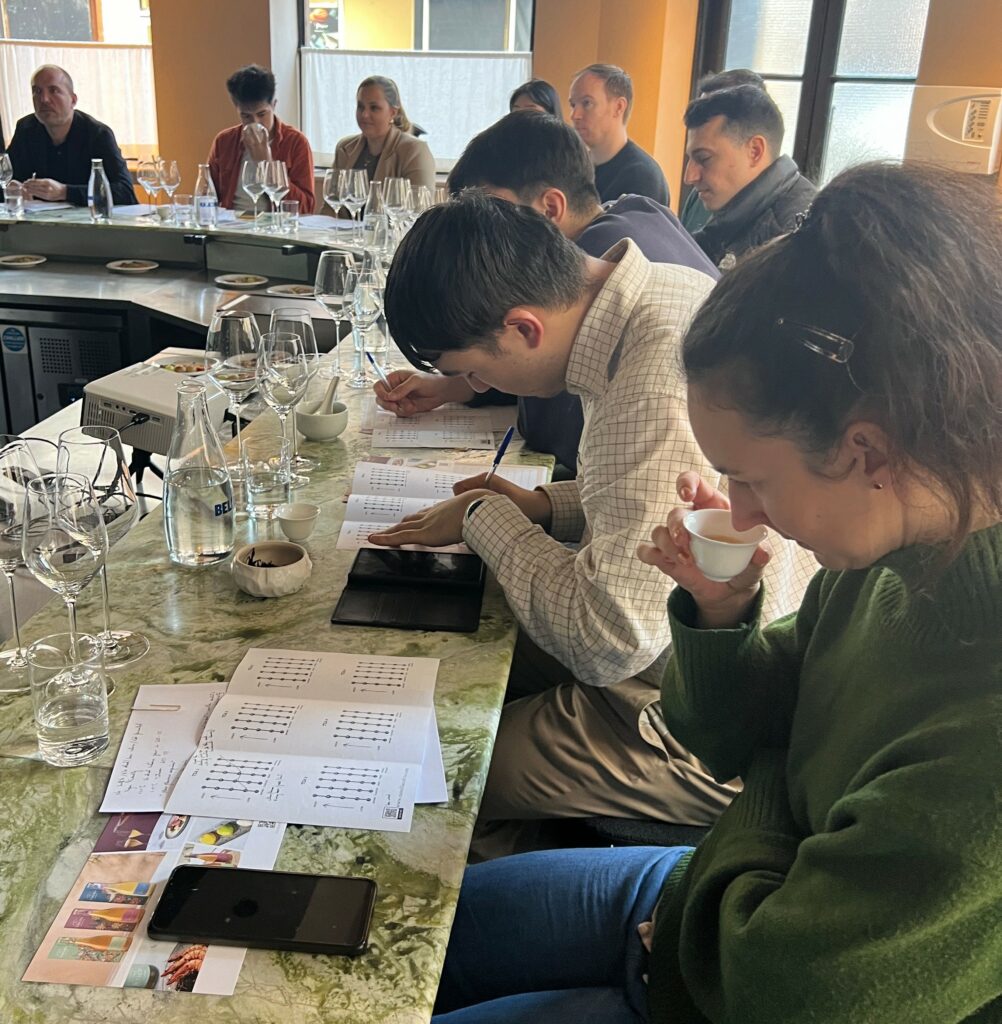
The result is quite spectacular – the sparkling teas we tasted were nuanced and delicate. The Jasmine sparkling tea having a sweeter, floral profile reminiscent of an Alsace wine perfect for creamy sauces and even dessert pairing. The Darling, as you would expect had more body and tannin – a savoury profile suited to more robust dishes. The surprise to our sommeliers was the Hojicha sparkling tea – full of the umami characteristics and appealing smokiness that you would enjoy with sushi or cured foods.
As more consumers seek wellness-oriented options, offering premium teas, like Saicho, is very much aligned with the trend towards mindful drinking. Just like wine, tea has the flavours that can complement a variety of cuisines, making it a valuable tool for elevating dining experiences.
Sparkling teas tasted
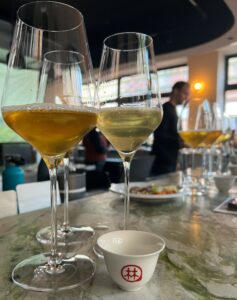
Saicho Sparkling Jasmine Tea – Scented with jasmine blossoms, this green tea from Fuding, in Fujian province, China, has a delicate floral aroma and notes of apple sherbet, lychee and vanilla.
Saicho Sparkling Darjeeling Tea – This black tea was grown in the foothills of the Himalayas in Darjeeling, India. Harvested in the summer to develop its unique Darjeeling muscatel flavour, the tea has notes of mandarin, ginger, and wood spice and gentle, dry tannins.
Saicho Sparkling Hojicha Tea – Originating in Kyoto in the 1920s as a way of utilising leftover leaves, stems, stalks and twigs, Hojicha is a roasted green tea from Japan. The tea has a deep umami character and notes of nori seaweed, roasted hazelnut and delicate smoke, with dry and woody tannins.
The hot teas tasted
Green Tea (Sanxia Township, Taiwan)
Red Oolong (Nantou County, Taiwan)
Heavy Roasting Oolong (Nantou County, Taiwan)
Saicho Jasmine Green Tea (Fuding, Fujian, China)
Saicho Hojicha (Tenryu, Shizuoka, Japan)
Saicho Gopaldhara Estate Black Tea (Darjeeling, India)
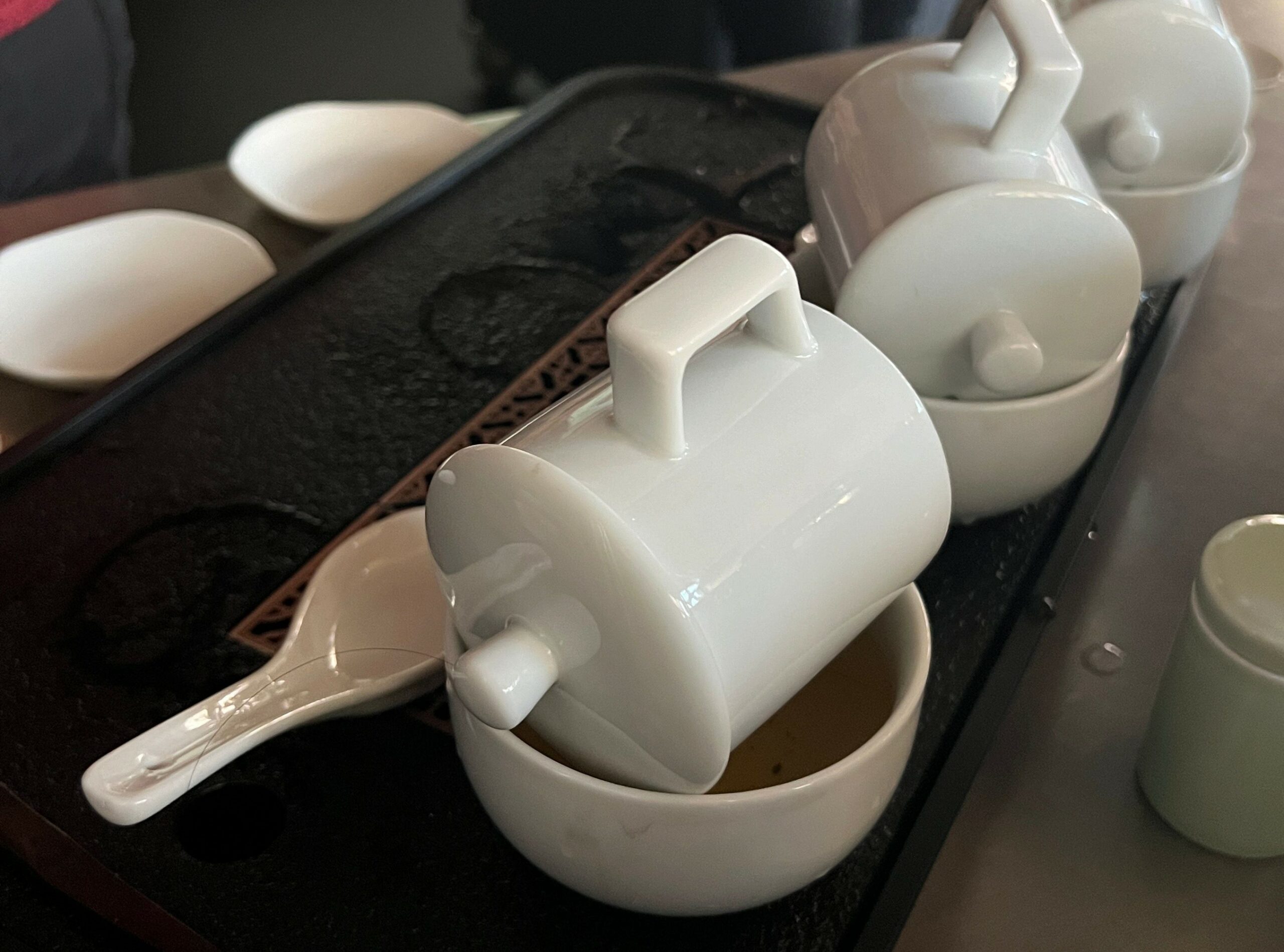
The Saicho story
Charlie and Natalie have a passion for food and drink. Now, husband and wife, they met whilst studying PhDs in Food Chemistry. Natalie can’t drink alcohol due to alcohol intolerance and so she hasn’t been able to fully enjoy the food and wine pairings that Charlie so loves. Natalie is not alone. More and more people are moderating their alcohol consumption, but still want to feel included in life’s celebratory moments. Wanting to create something that has the complexity and heritage of wine, but with its own unique flavour, history and culture, Natalie and Charlie turned to tea.
This came to a head, one night in an upscale restaurant. With limited soft drink options, Natalie had to make do with her usual glass of tap water. Enviously, she watched on as Charlie was regaled with stories of far-flung vineyards and detailed advice as to which specific dish’s tones and textures were most enhanced by a particular vintage and why. It was clear that Natalie was missing out on a huge aspect of the fine dining experience. So, this got them thinking; surely there could be a non-alcoholic drink with ingredients that possessed the same sort of complexity and heritage that wine does.
Hailing from Hong Kong, Natalie had grown up drinking tea with food so knew it could create the perfect pairing. With tea, it really matters at what point of year it’s harvested, the region it’s grown, its level of oxidation and the specific weather conditions of that particular season. Accordingly, you get a huge variety of different flavours from floral to fruity, nutty to smoky, candied to umami – all depending on the type, terroir and production method. Excited by this moment of inspiration, Charlie and Natalie enthusiastically threw themselves into the pain staking, 2-year process of sampling and experimentation. Having tested hundreds of different varieties from around the world they eventually settled on their first 3 teas.



